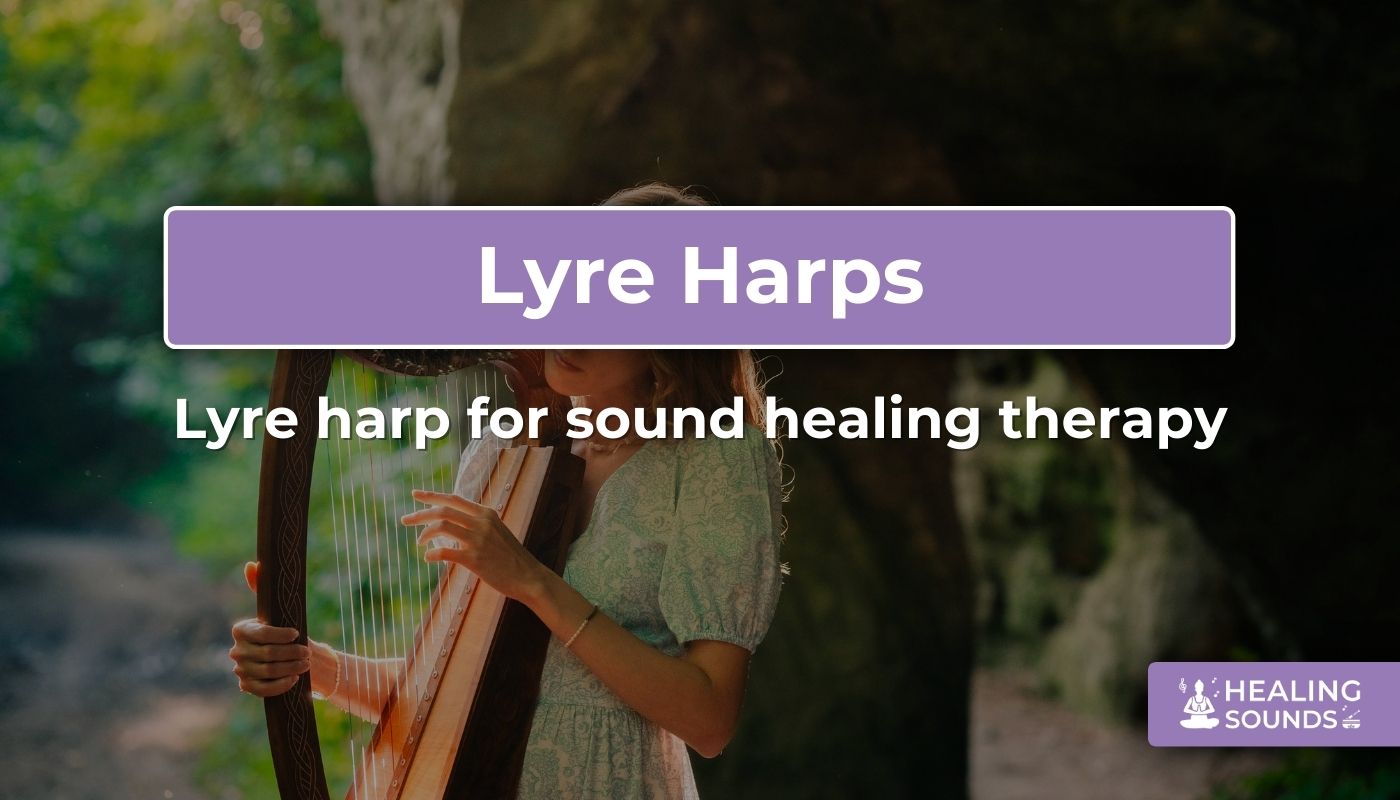The lyre harp, an instrument echoing through millennia, has long captivated hearts with its ethereal tones and profound spiritual connection. Today, this ancient stringed wonder is embracing a vital role in modern wellness, emerging as a cherished instrument in sound healing therapy. For wellness enthusiasts, therapists, and anyone drawn to the healing power of sound, the lyre harp offers a unique pathway to harmony. This guide explores the enchanting world of the lyre harp for sound healing therapy, delving into its history, therapeutic lyre harp benefits, playing techniques, and how Healing Sounds provides exceptional instruments crafted for this purpose.
What is a Lyre Harp and Its Ancient Roots?
So, what makes the lyre harp special? Descended from ancient Greek and Mesopotamian lyres, it's a stringed instrument typically characterized by a yoke or frame extending from a soundbox. While sharing similarities with larger harps, the lyre harp is often more compact and possesses a distinct, resonant voice ideal for intimate healing settings. Historically associated with Apollo, the Greek god of music and healing, the lyre has always carried connotations of harmony and balance.
Its gentle, plucked notes seem to float in the air, creating an atmosphere of calm and introspection. This unique sonic quality makes it more than just a musical instrument; it's a conduit for vibrational energy used effectively in sound healing therapy.
The Science and Soul of Sound Healing Therapy
Before diving deeper into the lyre harp's specific role, let's briefly touch upon how sound healing therapy works. This practice uses vibrations from instruments, voice, or technology to target physical, emotional, and mental imbalances. The core principle is resonance – the idea that the vibrations from the sound source can interact with the body's own vibrational field, encouraging it to return to a state of equilibrium.
Scientific studies suggest that specific sound frequencies can influence brainwave patterns, shifting them from alert states (beta waves) to more relaxed states (alpha and theta waves). This shift can significantly reduce stress, anxiety, and promote deep relaxation. As noted by the National Center for Complementary and Integrative Health, music therapy, a related field, shows promise in various health applications.
How Does the Lyre Harp Contribute to Sound Healing?
The lyre harp is uniquely suited for sound healing due to its specific tonal qualities and historical significance. Its vibrations are gentle yet penetrating, making it an accessible and effective instrument for various therapeutic applications.
Reducing Stress and Promoting Relaxation
The soothing, predictable patterns of lyre music can directly impact the nervous system. Playing or listening to the lyre harp helps activate the parasympathetic nervous system – the body's 'rest and digest' mode. This counteracts the effects of chronic stress, lowers heart rate and blood pressure, and fosters a profound sense of calm.
Enhancing Meditation and Mindfulness
The clear, pure tones of the lyre harp act as an anchor for the mind. Incorporating its sounds into meditation practices can help quiet mental chatter, deepen focus, and facilitate a more mindful state. Its simplicity allows even beginners to create calming soundscapes.
Balancing Energy Centers (Chakras)
In energy healing traditions, specific musical notes and frequencies are associated with the body's chakras or energy centers. While precise tuning can vary, the resonant frequencies produced by a lyre harp can be used intentionally to help clear blockages and restore flow within the energetic body, promoting overall well-being.

23-String Lyre Harp Instrument with Levers
$479.90 $623.90
This versatile lever harp offers a wide note range, perfect for exploring diverse melodies and frequencies in your sound healing therapy sessions.
Explore the 23-String LyreLyre Harp vs. Traditional Harp: Key Differences for Therapy
A common question is: What is the difference between a harp and a lyre? While both are stringed instruments, key distinctions exist:
- Size & Portability: Lyre harps are generally smaller, lighter, and more portable than concert or folk harps, making them easier to use in various settings, including bedside therapy or outdoor sessions.
- Structure: Traditional harps have strings running perpendicular to the soundboard, attached to a neck and pillar. Lyres typically have strings running parallel or at a slight angle over a bridge to a crossbar held by two arms extending from the resonating body.
- Sound & Resonance: While both produce beautiful sounds, lyres often have a brighter, clearer tone, sometimes described as more ethereal, compared to the often richer, fuller sound of a larger harp. The lyre's resonance is potent for close-proximity sound healing.
For many practitioners focusing on personal use, portability, and specific vibrational qualities, the lyre harp offers distinct advantages in sound healing therapy.
Practical Techniques for Using Your Lyre Harp
Harnessing the lyre harp benefits doesn't require complex musical training. Here are some accessible lyre harp techniques for sound healing:
Simple Strumming for Daily Calm
Find a quiet space. Hold the lyre harp comfortably. Gently strum across the strings, experimenting with upward and downward movements. Focus on your breath and allow the sounds to wash over you. Even 5-10 minutes daily can make a difference.
Intentional Playing for Chakra Alignment
If familiar with chakra frequencies, you can tune your lyre (if adjustable) or focus intention while playing specific strings or patterns associated with each energy center. Pluck strings corresponding to the root chakra for grounding, or higher strings for crown chakra connection.
Creating Sound Baths
Use the lyre harp alongside other instruments like singing bowls or chimes to create immersive sound baths. Play sustained notes or gentle arpeggios to build a field of resonant sound, facilitating deep relaxation for yourself or others.
Discover Your Perfect Lyre Harp for Healing

17 String Rosewood Lyre Harp Instrument by Hluru
$59.90
$79.90
Crafted from resonant rosewood, this lyre harp offers warm tones ideal for personal meditation and initiating your sound healing therapy journey. Learn more ➔

24 String Lyre Harp Instrument with Steel Strings
$89.90
$116.90
Featuring bright steel strings, this 24-string lyre harp produces clear, uplifting sounds perfect for energy clearing and adding sparkle to sound healing sessions. Learn more ➔

16-String Lyre Harp Instrument for Beginners
$69.90
$90.90
An excellent starting point, this accessible 16-string lyre harp is perfect for beginners exploring the fundamentals of music and sound healing therapy. Learn more ➔
Choosing the Right Lyre Harp for Your Healing Journey
Selecting the best lyre harp depends on your needs and intentions. Consider:
- Number of Strings: Fewer strings (e.g., 7-10) can be simpler for beginners, while more strings (16+) offer greater melodic possibilities.
- Material: Wood type (like rosewood, maple, mahogany) significantly impacts tone. Solid wood generally provides richer resonance than laminates.
- Tuning: Some lyres are pentatonic (easy, harmonious scale), while others are diatonic or chromatic (more versatile). Levers allow for quick key changes.
- Comfort & Size: Ensure the lyre feels comfortable to hold and play. Consider portability if you plan to travel with it.
- Start with a pentatonic-tuned lyre for easy, harmonious playing.
- Don't worry about "correct" notes initially; focus on the feeling of the vibrations.
- Explore simple strumming patterns before trying complex melodies.
- Listen deeply to the sounds you create and notice their effect on you.
The Symbolic Meaning of the Lyre Harp
Beyond its sound, what does the lyre harp symbolize? Historically and culturally, it represents several powerful concepts:
- Harmony and Order: Linked to Apollo, the lyre symbolizes cosmic order, balance, and the harmonious integration of different elements.
- Healing and Prophecy: Also associated with Apollo's healing aspects, the lyre represents the therapeutic power of music and divine inspiration.
- Poetry and Art: It's a symbol of artistic expression, particularly poetry and song, signifying the connection between creativity and the soul.
- Moderation and Purity: In contrast to more wild instruments in mythology, the lyre often stands for reason, clarity, and moderation.
Understanding this symbolism can add another layer of intention and meaning to your sound healing therapy practice with the lyre harp.
Conclusion: Embrace Harmony with the Lyre Harp
The lyre harp is far more than an ancient relic; it's a vibrant, accessible, and potent instrument for contemporary wellness. Its unique ability to soothe the nervous system, deepen meditation, balance energy, and connect us to a sense of harmony makes it an invaluable asset in sound healing therapy. Whether you are a seasoned practitioner seeking a resonant tool or an individual searching for personal peace and stress relief, the gentle vibrations of the lyre harp offer profound benefits.
Explore the collection at Healing Sounds to find a high-quality lyre harp that resonates with your healing journey. Let its timeless melodies guide you towards greater well-being and inner alignment.
Frequently Asked Questions about Lyre Harps for Sound Healing
Many instruments are used in sound healing therapy, including singing bowls (crystal and Tibetan), tuning forks, gongs, drums, chimes, the human voice, and stringed instruments like the lyre harp. The choice often depends on the practitioner's style and the specific therapeutic goals.
The lyre harp symbolizes harmony, balance, order, healing, artistic inspiration (especially poetry and music), and moderation. Its historical ties to figures like Apollo associate it with both the therapeutic and divine aspects of music.
Sound healing therapy works on the principle of resonance. Sound vibrations from instruments interact with the body's energy field and cellular structure, promoting relaxation by influencing brainwave states, reducing stress hormones, and potentially helping to restore the body’s natural harmonious frequencies for improved well-being.
Key differences include size (lyres are typically smaller and more portable), structure (string attachment and frame design differ), and often sound quality (lyres can be brighter or more ethereal). Both are string instruments, but the lyre harp often refers to smaller, lyre-shaped instruments used similarly to harps.
The lyre harp aids sound healing through its soothing vibrations and tones, which can reduce stress, promote relaxation, enhance meditation, balance energy centers (chakras), and create a peaceful atmosphere. Its portability and ease of play make it accessible for both personal and therapeutic use in sound healing therapy.

